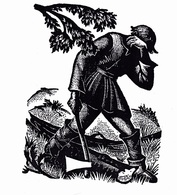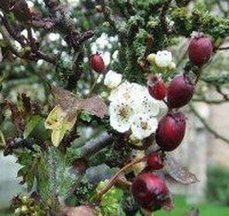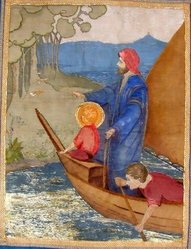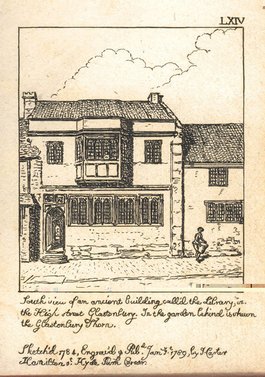The Story of the Glastonbury Thorn : The Early Chapters...
|
The story begins with the tales of Joseph of Arimathea, uncle to Christ, arriving in Glastonbury, a peninsula island surrounded by an inland sea and connected only to the rest of England by a tiny strip of land to the East. The Mendip Hills, surrounding the island were rich with tin and Joseph, a wealthy tin merchant is said to have visited the area many times; the stories also hinting that he brought the boy Jesus with him. Following the crucifixion, Joseph is said to have arrived at Glastonbury, accompanied by twelve companions. The first references to this are attributed to Rabinus Maurus (AD766 – 856) and that the companions included Mary, mother of Jesus, her sister Martha and Mary Magdalene. Tired and weary, Joseph thrust his staff into the ground on Wearyall Hill, where it took root and flourished.
The monk, John of Glastonbury (1393-1464) when assembling a chronicle of the history of Glastonbury Abbey, stated that when Joseph came, he brought with him a wooden cup used in the Last Supper and two cruets, one holding the blood of Christ, and the other his sweat, washed from his body. The legends go on to say that he buried the wooden cup on what is now known as Chalice Hill. ‘The holly thorn, which is so famous and so much visited and frequented on 1642 – 1651 saw the time of the English Civil War and the execution of Charles I, the replacement of the monarchy with the Commonwealth of England (1649–53), followed by a Protectorate (1653–59) under the personal rule of Oliver Cromwell.
Charles Eyston ( 1667 - 1721) an English antiquary writes:
'My curiosity having led me twice to Glastonbury within these two years, and inquiring there into the antiquity, history, and rarities of the place, I was told by the innkeeper where I set up my horses, who rents a considerable part of the enclosure of the late dissolved abbey, that St. Joseph of Aramathea landed not far from the town, at a place where there was an oak planted in memory of his landing, called the Oak of Avalon; that he and his companions marched thence to a hill near a mile on the south side of the town, and there being weary, rested themselves; which gave the hill the name of Weary-all-Hill; that St. Joseph stuck on the hill his staff, being a dry hawthorn-stick, which grew, and constantly budded and blowed upon Christmas-day; but, in the time of the Civil Wars, that thorn was grubbed up. However, there were, in the town and neighborhood, several trees raised from that thorn, which yearly budded and blowed upon Christmas-day, as the old root did.' The belief that the Glastonbury Holy Thorn blossomed on Christmas Day created great stress when in 1753, the British Calendar was altered to bring Britain into line with Europe and eleven days were dropped from the month of September. ‘The Gentleman’s Magazine’ a publication of that time, reported: “A vast concourse of people attended the noted thorn on Christmas-day, new style; but, to their great disappointment, there was no appearance of its blowing, which made them watch it narrowly the 5th of January, the Christmas-day, old style, when it blowed as usual." Contrary to media portrayal in that the same Thorn has always stood on the hill, there have been ongoing plantings of the Glastonbury Thorn down the centuries, not only on Wearyall Hill but all over the town.
|
The thorn is a variety known as Crataegus monogyna biflora usually seen in the Middle East and unusual in that it flowers twice a year, in spring and again in winter, when the fruits of the spring blossoms are still the tree. The average life span of the tree is approximately 100 years but some have survived for several centuries. Many have tried to grow the Glastonbury Thorn from seed and direct cuttings, but it can only be grown by being grafted onto the common hawthorn, Crataegus monogyna.
Legend has it that Joseph of Arimathea made frequent visits to the area and is reputed to have been accompanied by Jesus as a young boy. The image above is a banner and can be seen in St John the Baptist, parish church of Pilton, formerly known as St Mary's and renamed after the Reformation. It was embroidered in the early 1930s and shows Joseph and Jesus arriving at Pilton 'harbour'. Formerly known as Pooltown, the village is on the edge of the Somerset Levels, which formed a vast tidal lake in Saxon times.
“And did those feet in ancient time" is a short poem by William Blake from the preface to his epic Milton a Poem. The date of 1804 on the title page is probably when the plates were begun, but the poem was printed c.1808.
Today it is best known as the anthem "Jerusalem", with music written by Sir Hubert Parry in 1916. The poem was inspired by the apocryphal story that a young Jesus, accompanied by Joseph of Arimathea, a tin merchant, travelled to this area and visited Glastonbury during the unknown years of Jesus. The legend is linked to an idea in the Book of Revelation (3:12 and 21:2) describing a Second Coming, wherein Jesus establishes a New Jerusalem. The Christian Church in general and the English Church in particular, has long used Jerusalem as a metaphor for Heaven, a place of universal love and peace. |
|
In 1784, topographical artist John Carter visited Glastonbury and drew (right) what he refers to as the Library, now known as the Tribunal and currently housing the Tourist Information Centre and the Lake Village Museum. In his notes, he makes mention of a Glastonbury Thorn as being in the garden to the rear. There was also at least one Victorian attempt to replant a Thorn on Wearyall Hill, in 1863, as part of Prince of Wales’ wedding celebrations. "At 10.30 a procession was formed in the Kitchen Grounds and at 11 the Mayor and Town Council arrived and took their appointed places in it. It passed through Magdalen-street, Market-place, High-street, Chilkwell, Bere-lane, to Weary-all-hill, where some ladies planted a thorn". (The History of Glastonbury during the last 40 years. A lecture delivered at Glastonbury by G W Wright. Reprinted from the Avalon Independent – 1890) |
Read on for Recent Chapters in the Story of the Glastonbury Thorn...
Early Chapters | Recent Chapters | Branches further afield | Branches in the UK | Branches overseas
Places to Visit | Bride's Mound | Chalice Well & Gardens | The Church of St John the Baptist | Glastonbury Abbey | The Glastonbury Experience Courtyard | Glastonbury Goddess Temple | Glastonbury Thorn | Gog & Magog | Lake Village Museum | Library of Avalon | St. Margaret's Chapel & the Magdalene Almshouses | Somerset Rural Life Museum | Ponter's Ball | The Glastonbury Tercentennial Labyrinth | Glastonbury Tor | Wearyall Hill | White Spring |




